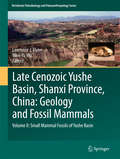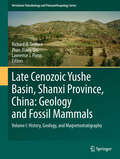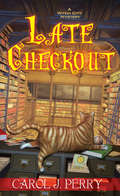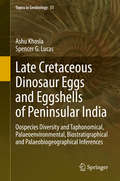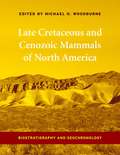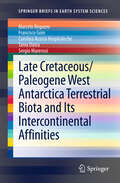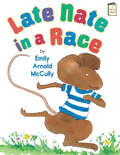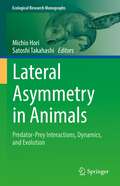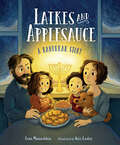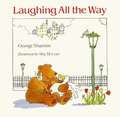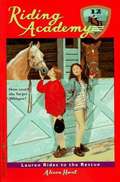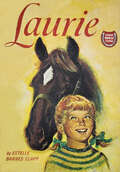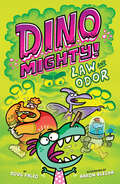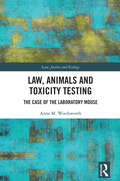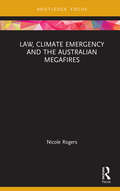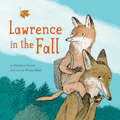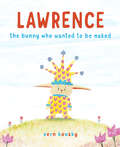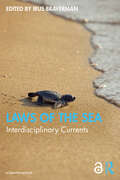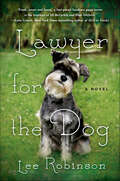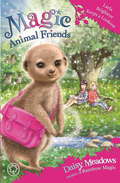- Table View
- List View
Last of the Dinosaurs (Time Machine #22)
by Peter LerangisYou have traveled back to a time when dinosaurs rule the earth. You're alone in a prehistoric pine forest when a huge dinosaur -- a flesh-eating megalosaurus -- comes staggering toward you. It looks sick and weak -- but suddenly it turns on you with a tremendous roar! You can run from the angry creature or jump quickly to another era. Your decision can lead you to safety -- or leave you stranded in time! Are you ready to face the danger?
Late Cenozoic Yushe Basin, Shanxi Province, China: Geology and Fossil Mammals
by Lawrence J. Flynn Wen-Yu WuThis volume focuses on small mammal fossils from extinct Asian faunas of about 1 to 7 million years ago in North China. These played a role in the emergence of vertebrate paleontology as a modern science in that country. This second volume of the sub-series Late Cenozoic Yushe Basin, Shanxi Province, China: Geology and Fossil Mammals in the Vertebrate Paleobiology and Paleoanthropology book series deals with a rich microfauna fossil record; megafauna follow in subsequent volumes. This research on Yushe Basin fossils provides a view of changes in northeast Asian terrestrial faunas during the Late Neogene, and therefore is a key to the biochronology for a vast part of the continent. The faunas recovered by the multinational team working in this region represent changes in small mammal communities of the Yushe Basin, revealed on a finer time scale that has not been achieved previously. Detailed systematic studies on small mammal groups proceeded under the care of specialists are outlined in the chapters of this volume. Paleontologists, ecologists and evolutionary biologists will find this book appealing.
Late Cenozoic Yushe Basin, Shanxi Province, China: Volume I:History, Geology, and Magnetostratigraphy
by Lawrence J Flynn Richard H Tedford Zhan-Xiang QiuThe Late Cenozoic Yushe Basin, Shanxi Province, China embodies the bulk of our knowledge on successions of terrestrial vertebrates in the northern part of East Asia. Everything we know about Asian mammals of the last 6 million years has a historical basis in the documentation of the geology of Yushe. This volume introduces the basin in its geological setting, describes the succession of fossiliferous strata, and shows how it is dated. It develops an unsurpassed level of precision for its age control. Geological maps and stratigraphic sections provide the backbone for individual studies to follow on varied fossil groups. The volume explores the history of exploration of the last century in Yushe Basin and places development of paleontology there into the context of the birth of the modern epoch of science in China.
Late Checkout (A Witch City Mystery #9)
by Carol J. PerryA dead ballplayer means foul play in Salem . . . Field reporter Lee Barrett is not happy that her hours are being cut back at WICH-TV, although it is nice to spend more time volunteering with Aunt Ibby, a research librarian at Salem's main branch. But Lee's least favorite task is going up to the stacks, a spooky, seldom-frequented upper section of the library. On this day she has good reason to be afraid—she finds a dead man, surrounded by hundreds of scattered books and torn-out pages. Her police detective beau, Pete Mondello, is soon on the scene, and the deceased is identified as a former minor league baseball player—and ex-con—named Wee Willie Wallace, who hasn't been seen in Salem for twenty years. With help from her friend River's Tarot reading, her clairvoyant cat O'Ryan, and Lee's own psychic gifts, she steps up to the plate to catch the killer who took the old ballplayer out of the game . . . Praise for the Witch City Mysteries“Perfectly relaxing and readable.”—Kirkus Reviews “This rewarding paranormal cozy series debut will have Victoria Laurie fans lining up to follow.”—Library Journal “An entertaining story that keeps readers guessing until the very twisted and eerie end.” —RT Book Reviews
Late Cretaceous Dinosaur Eggs and Eggshells of Peninsular India: Oospecies Diversity and Taphonomical, Palaeoenvironmental, Biostratigraphical and Palaeobiogeographical Inferences (Topics in Geobiology #51)
by Spencer G. Lucas Ashu KhoslaThis book documents analyses of the Late Cretaceous dinosaur nesting sites of the Lameta Formation at Jabalpur, Districts Dhar and Jhabua, Madhya Pradesh; Districts Kheda and Panchmahal (Gujarat); and the Pisdura, Dongargaon and Pavna sectors in the Chandrapur Districts of Maharashtra, which are exposed in India along an east-west and central axis. In this work, special emphasis has been given to the dinosaur nesting sites of the east-central Narbada River region, including its regional geology. The work was undertaken to provide detailed information concerning dinosaur eggs, eggshell fragments, nests and clutches found in the Lameta Formation of peninsular India. Prior to the present work there had been no detailed review of systematic work on the taxonomy, and of micro- and ultrastructural studies of dinosaur eggs and eggshells from the Lameta Formation. The study documents the field and laboratory investigations that facilitated the reconstruction of the morphotaxonomy, models for the burial pattern of eggs and eggshells, taphonomic implications,and the palaeoenvironmental context and palaeoecological conditions during the Late Cretaceous at the time of the extrusion of the Deccan traps, which may have been partly responsible for the extinction of the dinosaurs. The need to follow a parataxonomic classification for Indian dinosaur eggs and eggshell types is very apparent, and this book addresses this aspect in some detail. The emphasis on the application of parataxonomic schemes is based on the description of new oospecies and their comparison with previously known forms. The present work has led to the recovery of numerous nests, many collapsed eggs and hundreds of dinosaur eggshell fragments from the localities situated near the east, west and central Narbada River regions. It will be of interest to academics and professional palaeontologists, and all students of dinosaurs.
Late Cretaceous and Cenozoic Mammals of North America: Biostratigraphy and Geochronology
by Michael WoodburneThis book places into modern context the information by which North American mammalian paleontologists recognize, divide, calibrate, and discuss intervals of mammalian evolution known as North American Land Mammal Ages. It incorporates new information on the systematic biology of the fossil record and utilizes the many recent advances in geochronologic methods and their results. The book describes the increasingly highly resolved stratigraphy into which all available temporally significant data and applications are integrated. Extensive temporal coverage includes the Lancian part of the Late Cretaceous, and geographical coverage includes information from Mexico, an integral part of the North American fauna, past and present.
Late Cretaceous/Paleogene West Antarctica Terrestrial Biota and its Intercontinental Affinities
by Marcelo Reguero Francisco Goin Tania Dutra Sergio Marenssi Carolina Acosta HospitalecheOne of the most intriguing paleobiogeographical phenomena involving the origins and gradual sundering of Gondwana concerns the close similarities and, in most cases, inferred sister-group relationships of a number of terrestrial and freshwater vertebrate taxa, e.g., dinosaurs, flying birds, mammals, etc., recovered from uppermost Cretaceous/ Paleogene deposits of West Antarctica, South America, and NewZealand/Australia. For some twenty five extensive and productive investigations in the field of vertebrate paleontology has been carried out in latest Cretaceous and Paleogene deposits in the James Ross Basin, northeast of the Antarctic Peninsula (AP), West Antarctica, on the exposed sequences on James Ross, Vega, Seymour (=Marambio) and Snow Hill islands respectively. The available geological, geophysical and marine faunistic evidence indicates that the peninsular (AP) part of West Antarctica and the western part of the tip of South America (Magallanic Region, southern Chile) were positioned very close in the latest Cretaceous and early Paleogene favoring the "Overlapping" model of South America-Antarctic Peninsula paleogeographic reconstruction. Late Cretaceous deposits from Vega, James Ross, Seymour and Snow Hill islands have produced a discrete number of dinosaur taxa and a number of advanced birds together with four mosasaur and three plesiosaur taxa, and a few shark and teleostean taxa.
Late Nate in a Race (I Like to Read)
by Emily Arnold McCullyOn the day of the race, Nate is running late. Find out what happens when he tries out going fast in this Guided Reading Level D story. Nate likes to go slow. His brother and sister are worried they'll miss the race—but mom tells them not to nag him. When they get there, Mom convinces Nate to try, too. . . . And Nate finds out sometimes he likes to go slow, but sometimes he likes to go fast! With colorful, kid-friendly illustrations by Caldecott Honor artist Emily Arnold McCully, this simple story about the rewards of trying new things is perfect for emergent readers. The award-winning I Like to Read® series focuses on guided reading levels A through G, based upon Fountas and Pinnell standards. Acclaimed author-illustrators--including winners of Caldecott, Theodor Seuss Geisel, and Coretta Scott King honors—create original, high quality illustrations that support comprehension of simple text and are fun for kids to read with parents, teachers, or on their own! Suitable for late kindergarten readers, Level D books feature wider vocabulary, longer sentences, and greater variety in sentence structure than levels A, B, and C. When Level D is mastered, follow up with Level E.
Late To Smile
by K. M. PeytonWhen her glamorous, overbearing mother dies at the age of ninety, Miranda experiences an enormous sense of release. But she still has to cope with an immature and dominating husband with a consuming passion for buying and riding race horses. Miranda supports her four grown-up children as they escape to new lives, but it is only when tragedy strikes that she sees her own future opening up, with undreamed of possibilities ... Recounting the renaissance of one 'ordinary' middle-aged farmer's wife, K.M. Peyton's engaging, compassionate new novel depicts with acute observation and humour the lives and idiosyncrasies of a close-knit farming and racing community in East Anglia, with its hair-raising hunts and point-to-points and a fascinating assortment of characters, including a prolific vicar, millionaire gypsies, an expansionist farmer called Napoleon and Ianthe, a London seductress.
Lateral Asymmetry in Animals: Predator-Prey Interactions, Dynamics, and Evolution (Ecological Research Monographs)
by Satoshi Takahashi Michio HoriThis book presents the latest research findings on the laterality of fish and other animals. It describes all aspects of lateral asymmetry, including ecology, morphology, behaviour, dynamics of lefty and righty morphs, genetics and evolution, through field observations, experiments and modeling. Lateral asymmetry in scale-eating cichlids gives a simple and beautiful example of negative frequency-dependent selection and resulting oscillation of lefty and righty morph frequencies. Lateral dimorphism is found not only in scale-eaters but in all orders of fish, shrimps and cuttlefish. Lateral asymmetry interacts between species through "cross-predation." Contrary to fish, lateral asymmetry in snails acts as, in most cases, positive frequency-dependent selection and provides deep insights into speciation. Especially, snakes eating righty snails facilitate speciation of lefty snails.As a collaboration work of field ecologists and theoretical biologists, this book covers a variety of topics on lateral asymmetry, which are consistently related to predation. The topics include behavioral ecology, population dynamics, physiology, evolution, genetics, development, learning and neuroscience, statistics, with the subjects of fish, shrimp, prawn, and crayfish, crab, cuttlefish, and snake and snail. Chapters cover new research results such as cuttlefish laterality dynamics, interaction between laterality of snails and snakes, evolution of laterality genetic system, and statistical analysis of laterality oscillation. Readers will appreciate the simplicity and beauty of lateral asymmetry and its profound impact on ecology and evolution.
Latkes and Applesauce: A Hanukkah Story
by Fran ManushkinA cat and dog create a Hanukkah miracle, just in the nick of time in this updated reissue of the beloved holiday classic.The Menashes love latkes and applesauce during Hanukkah. But a blizzard begins and erases any hope that they&’ll harvest potatoes and apples in time. When a stray cat and dog show up, there&’s not a lot of food to offer them, but kindness prevails, and they&’re invited in. It turns out that the dog—Latke—and the cat—Applesauce—save the day.
Laughing All The Way
by George ShannonFrom the book: "Fiddle figs!" grumbled Duck. "It's the worst-ever worst-ever worst day of all my life." Bear catches Duck and tries to pluck out all his feathers, but Duck outsmarts him.
Laughter, The Best Medicine: Those Lovable Pets
by Editors of Reader's DigestPeople are funny, but so are the animals we love-and our day-to-day relationships with them can be even more entertaining. Dogs and cats obviously rule the comedic roost, but parrots, parakeets, and other talking birds are often an endless source of amusement as well. Even our connection to bunnies, hamsters, and the occasional white rat can evoke a good laugh. The 500-plus pet anecdotes, cartoons, and quotes in Laughter Is The Best Medicine: Those Lovable Pets have been collected from more than eight decades' worth of Reader's Digest magazines and are guaranteed to cheer up your day. You'll meet the woman whose dog trembled at the "Beware of Dog" sign in their front yard until she told him, "Relax! It's you!"; the vet whose advice to a woman whose cat had swallowed lots of unpopped popcorn was, "first, keep him out of the sun"; the mother-in-law who concealed her way-too-plump piglet's weight loss pills in ice cream; and much more. Our furry or fine feathered friends not only warm our hearts but also amuse us (and our joke writers, too) with their antics-one reason, no doubt, the market for this book is so vast: At the minimum, 40 percent of American households own at least one pet.
Lauren Rides to the Rescue (Riding Academy #12)
by Alison HartLauren sees Melanie Harden "training" Whisper and accuses her of abusing her. And now she sets off to save Whisper from being abused.
Laurie (Famous Horse Stories)
by Estelle Barnes ClappWhat would you do if you were ten years old and you wanted a horse more than anything in the world? Laurie did! She wanted Fella so much that she was willing to get up at five in the morning to feed him, knock herself out of the loft pitching his hay, and practice riding him until she couldn't sit down! A lot of work for a little girl, but Laurie felt it was worth it if she could earn the right to have Fella for her very own. This is a family story, for Mother and Dad, Tim and the dog Donny, as well as Ricky and the Slater tribe, play a large part in the delightful saga of the conquest of Fella. But Laurie, who steams purposely past such pitfalls as fist fights and an inability to master simple arithmetic, has the first and last word.
Law Enforcement Dogs (Working dogs)
by Phyllis Raybin EmertFrom the book Jacket: Dogs are being used in police departments around the world to find and catch criminals "in the act." Special training is required, and this book explains how this is done. This easy to read nonfiction book is suitable for students in Grades 2 - 4 to learn about the different jobs that dogs do in law enforcement, from sniffing out bombs and drugs, to helping to protect officers, find suspects in buildings, and help protect citizens from harm.
Law and Odor: Dinosaur Graphic Novel (Dinomighty! #3)
by Doug PaleoCrime is bubbling up in Dinotown . . . and it stinks! In this hilarious graphic novel, the Dinomighties need to sniff out their smelliest mystery yet. Will their noses lead them to the culprit? Or will the odor of their enemies prevail? Perfect for fans of The InvestiGators, Dog Man, and Real Pigeons Fight Crime. When the mayor tells the Dinomighties that there's been a theft of famous purple beans at the How You've Bean factory, they are hot on the trail.Using their peak investigative skills to hunt down crime clues and interrogate potential suspects, they soon run out of gas and into airtight alibis. A look to the nemesis list points squarely to the gaseous Gasosaurus, but the Dinomighties need proof before they can pin down this baddie.In their grimiest case yet, T-Lex, Teri, Dave, and Bok follow their noses to sniff out and solve this musty mystery with high-tech crime-solving gadgets, action-packed chases, bad-guy-busting buddy power, and a whole lot of laughs.
Law, Animals and Toxicity Testing: The Case of the Laboratory Mouse (ISSN)
by Anne M. WordsworthDrawing on our growing knowledge of animal cognition, this book provides a critical analysis of the use of animals in the legal regime and the practice of toxicity testing.Although animal abuse has become a major issue, animal testing remains largely in the shadows, even though it involves substantial cruelty. Toxicity testing, in particular, imposes considerable pain, suffering and ultimately death on those laboratory animals – often mice – chosen to demonstrate the characteristics of chemicals and their commercial potential. This book documents and critically analyzes the animal protection laws of the European Union, the United States and Canada. It not only examines the tests themselves and the suffering they inflict on animals but also exposes the failure of both the testing and the toxicity laws to effectively protect human health and the environment. Finally, the book takes up the potential of alternative non-animal testing methods to replace the current regimen and to reduce current damage to health and the environment.This book will be of interest to scholars and researchers in the fields of animal studies, environmental law and sociolegal studies, as well as activists and others with an interest in ethics and animal rights.
Law, Climate Emergency and the Australian Megafires
by Nicole RogersThis book addresses the ways in which the Black Summer megafires influenced the development of climate narratives throughout 2020. It analyses the global pandemic, and its ensuing restrictions, as a countervailing force in the production of such narratives. Lives and properties were lost in the spring and summer of 2019 and 2020, when catastrophic bushfires burnt through millions of hectares of mainland Australia. Nearly three billion native animals died. And for millions of Australians, and others worldwide, it was through the Australian megafires that the global climate emergency became tangible, concrete, no longer a comfortably deferred, albeit problematic abstraction which could be consigned to future generations to deal with. This book explores the legal and other implications of new understandings of climate emergency arising from the fires, and the emergence of a hierarchy of emergencies as the pandemic came to dominate global and domestic political discourses. It examines narratives of culpability, and legal avenues for seeking retribution from government and big fossil fuel emitters. It also considers the impact of the fires on the burgeoning phenomenon of climate activism, particularly in Australia, and the ways in which pandemic restrictions curtailed such activism. Finally, the book reflects on the fires through the lenses offered by climate fiction, and apocalyptic fiction more generally, in order to consider how these shape, and might shape, our responses to them. This important and timely book will appeal to environmental lawyers and socio-legal theorists; as well as other scholars and activists with interests in climate change and its impact. It is recommended for anyone concerned about current and future climate disasters, and the shortcomings in legal, political and popular responses to the climate crisis.
Lawless Labs: Good Labs Gone Bad
by Karin RonnowLab lovers beware, these doggy criminals are not the nice sweet dogs we all know and love, but are guilty of goofiness, theft, and grand larceny. Read on to see what all these criminal pups have done and what their punishments were.
Lawrence in the Fall
by Matthew FarinaWhen Lawrence Fox's teacher announces that students will be presenting their collections at show-and-tell, Lawrence realizes he doesn't have anything to share.Luckily, Papa knows just what to do to help! Together, they venture into the woods. Lawrence is scared at first, but as he grows comfortable in the forest, he starts to recognize its magic, and how beautiful and unique each tree and leaf is, allowing him to gather a splendid, one-of-a-kind collection of his own!
Lawrence: The Bunny Who Wanted to Be Naked
by Vern KouskyIn this funny, charming, and oh-so-relatable picture book, meet a young bunny named Lawrence who is determined to decide what he wears--or doesn't wear.Ever since he was a tiny bunny, Lawrence's mother has dressed him up in all the most fashionable clothes--the brightest colors and the most interesting styles. Lawrence wears homemade sweater suits. And inflatible helium balloon pants. The only problem? Lawrence hates wearing clothes and longs to hop naked through the fields--just like all the other bunnies.So Lawrence comes up with an ingenious plan to turn the tables on his mother. Ultimately, the mother-son duo devise a way to put their considerable creative talents to use, in a way that makes both of them happy. In this picture book that's perfect for Easter and year round, kids will laugh out loud at (and understand!) Lawrence's quest for independence, just as parents will identify with how hard it is to let go of your one-and-only special bunny....
Laws of the Sea: Interdisciplinary Currents
by Irus BravermanLaws of the Sea assembles scholars from law, geography, anthropology, and environmental humanities to consider the possibilities of a critical ocean approach in legal studies. Unlike the United Nations’ monumental Convention on the Law of the Sea, which imagines one comprehensive constitutional framework for governing the ocean, Laws of the Sea approaches oceanic law in plural and dynamic ways. Critically engaging contemporary concerns about the fate of the ocean, the collection’s twelve chapters range from hydrothermal vents through the continental shelf and marine genetic resources to coastal communities in France, Sweden, Florida, and Indonesia. Documenting the longstanding binary of land and sea, the chapters pose a fundamental challenge to European law’s “terracentrism” and its pervasive influence on juridical modes of knowing and making the world. Together, the chapters ask: is contemporary Eurocentric law—and international law in particular—capable of moving away from its capitalist and colonial legacies, established through myriad oceanic abstractions and classifications, toward more amphibious legalities? Laws of the Sea will appeal to legal scholars, geographers, anthropologists, cultural and political theorists, as well as scholars in the environmental humanities, political ecology, ocean studies, and animal studies.
Lawyer for the Dog: A Novel (The Sally Baynard Novels #1)
by Lee RobinsonOne of the sharpest attorneys in Charleston, S.C., Sally Baynard isn't your typical southern belle. She's certainly not what her mother hoped she'd grow up to be, especially since she divorced her husband, Family Court Judge Joe Baynard, and his historic family with their historic wealth and historic houses. Maybe Sally was never going to be a proper society lady, but her success as a public defender and family lawyer have been enough for her. She's represented murderers, burglars, drug dealers and lately has taken on some of the thorniest divorces, all cases closed with her Sally Bright Baynard wit, charm and brains. Or have they? One case she's never successfully closed is her marriage. And when Judge Joe assigns her to one of his divorce cases by appointing her as the Lawyer for the Dog -- Sherman, a miniature schnauzer-- she's forced into close quarters with him again. Juggling the needs of the dog, the angry owners, her amorous but uncommunicative ex-husband, her aging, Alzheimer's-ridden mother, and the expectations of the court is more than Sally could have imagined. And as rascally Sherman digs his way into Sally's heart, he brings along his charming vet Tony, a man who makes Sally question her views on love and marriage.
Layla Brighteye Keeps a Lookout: Book 26 (Magic Animal Friends #26)
by Daisy MeadowsWelcome to a magical world where animals talk and play - just like you and me!Lily and Jess are having lots of fun at Spelltop School, where the animals of Friendship Forest learn all about magic. But something is making the school's enchantment go wonky - it must be the work of the wicked witch, Grizelda...Can tiny meerkat Layla Brighteye spot what's wrong and help the girls save the school?An enchanting series full of adorable animals, magic and friendship - from the creator of RAINBOW MAGIC, the UK's bestselling series for girls aged 5-7.

